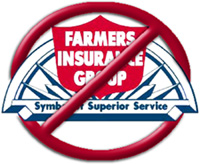


This Site is Unauthorized by Farmers Insurance Group
Home | Farmers Insurance Rated Worst! | Farmers Insurance Agent Info | Lawsuits| Direct Repair Program
Forum(Submit Complaint) | Contact
Dept of Insurance! | Farmers Insurance & Colossus | Sitemap | Search
Need Help/Lowballed? | Links | Blog | Our Story-Defending Free Speech | Lawyers | Contact Us
COTTAGE CAFÉ, INC., AND FARMERS INSURANCE GROUP
APPELLANTS
V.
PATRICIA COLLETTE
APPELLEE
CA05-734
February 1, 2006
APPEAL FROM THE ARKANSAS WORKERS' COMPENSATION COMMISSION
[NO. F400944]
AFFIRMED IN PART, REVERSED IN PART, AND REMANDED
John Mauzy Pittman, Chief Judge
Appellee, the claimant in this workers' compensation case, had been employed by appellant Cottage Café, Inc., as a grill cook for approximately nine years when the owner of that establishment sold the business to Mr. Leonard Cernak on September 12, 2003. The previous owner had workers' compensation insurance coverage with Southern Guaranty Insurance. Mr. Cernak obtained workers' compensation insurance coverage from Farmers Insurance Group. Farmers' coverage became effective on September 23, 2003. On September 29, 2003, appellee dropped a spatula from her hand and, unable to continue work, sought medical treatment resulting in a diagnosis of carpal-tunnel syndrome and cubital-tunnel syndrome. Neither of the insurers involved accepted the injury as compensable or accepted liability for the claim. After a hearing, the Commission found that the injury wascompensable and that Farmers Insurance was liable for the compensation and benefits awarded. On appeal, appellants Farmers Insurance and Cottage Café argue that the Commission erred in finding that the claimant's injury was compensable and in concluding that Farmers Insurance was liable for payment of benefits. We affirm in part and reverse in part.
We first address the question of the sufficiency of the evidence to support the Commission's finding that the claimant's injury was compensable. In reviewing decisions from the Workers' Compensation Commission, we view the evidence and all reasonable inferences deducible therefrom in the light most favorable to the Commission's findings and affirm if they are supported by substantial evidence, i.e., evidence that a reasonable person might accept as adequate to support a conclusion. Carman v. Haworth, Inc., 74 Ark. App. 55, 45 S.W.3d 408 (2001). We will not reverse the Commission's decision unless we are convinced that fair-minded persons with the same facts before them could not have reached the conclusions arrived at by the Commission. Wal-Mart Stores, Inc. v. Sands, 80 Ark. App. 51, 91 S.W.3d 93 (2002). Questions of weight and credibility are within the sole province of the Workers' Compensation Commission, which is not required to believe the testimony of the claimant or of any other witness, but may accept and translate into findings of fact only those portions of the testimony it deems worthy of belief. Strickland v. Primex Technologies, 82 Ark. App. 570, 120 S.W.3d 166 (2003). Once the Commission has made its decision on issues of credibility, the appellate court is bound by that decision. Id.
A compensable injury must be established by medical evidence supported by objective findings. Ark. Code Ann. § 11-9-102(4)(D) (Repl. 2002). A claimant seeking workers' compensation benefits for a gradual-onset injury must prove by a preponderance of the evidence that (1) the injury arose out of and in the course of his or her employment; (2) the injury caused internal or external physical harm to the body that required medical services or resulted in disability or death; and (3) the injury was a major cause of the disability or need for treatment. Ark. Code Ann. § 11-9-102(4)(A)(ii) and (E)(ii) (Repl. 2002). Because carpal-tunnel syndrome is by definition a gradual-onset injury, it is not necessary that the claimant prove that this injury was caused by rapid repetitive motion. See Kildow v. Baldwin Piano & Organ, 333 Ark. 335, 969 S.W.2d 190 (1998). However, because cubital-tunnel syndrome is not recognized as a per se rapid repetitive injury, the claimant was required to additionally prove by a preponderance of the evidence that this gradual-onset injury to her right elbow was caused by rapid repetitive motion. See Freeman v. Con-Agra Frozen Foods, 344 Ark. 296, 40 S.W.3d 760 (2001).
Here, the Commission's finding of compensability was based on the claimant's extensive testimony concerning her duties as a grill cook which required her to prepare eggs, omelets, hash browns, ham, sausage, and bacon, and to flip these foods with a spatula as they cooked. The Commission also relied upon testimony from several co-workers that the claimant was "good help" and a hard worker, and testimony from the mother of the café's previous owner that she had worked with the claimant and, from her observations, had nodoubt that the claimant's medical problems with her right arm resulted from her job duties. Co-workers also testified concerning the increasing difficulty that the claimant experienced in performing her job duties during the gradual onset of her injuries. Furthermore, the Commission relied on the opinion of one of the claimant's treating physicians, Dr. Kelly, that the claimant's carpal-tunnel and cubital-tunnel injuries were obviously related to claimant's repetitive use on her job, as well as the fact that there was no probative evidence before the Commission, medical or otherwise, to suggest that claimant's injuries resulted from any other cause or activity. The record supports these findings, and we cannot say that the Commission erred in finding that the claimant's carpal-tunnel and cubital-tunnel injuries were compensable.
However, we conclude that the Commission did err in finding that appellant Farmers Insurance was liable for the payment of benefits. The Commission, believing the question to be one of first impression, opted for what it called a "manifestation" approach to determining which carrier was liable, pursuant to which liability attaches when the injury "manifests" and the claimant begins to lose time from work, requires medical attention, and is no longer able to perform his job. Finding that "the true extent of the claimant's injury to her right wrist and elbow did not manifest itself until" appellant Farmers had become the carrier, it held that Farmers was liable for the claim.
The Commission cites neither authority nor public policy considerations supporting its adoption of this rule. Furthermore, it disregards prior opinions of the Arkansas appellatecourts that bear on the question under consideration, i.e., when does a scheduled gradual-onset injury legally commence? This court recently addressed this question in the context of the statute of limitations as follows: Our singular task on appeal is to determine the point in time that Pina sustained a compensable injury. It has long been held that the statute of limitations does not commence to run until the true extent of the injury manifests and causes an incapacity to earn wages sufficient to give rise to a claim for disability benefits. Hall's Cleaners v. Wortham, 311 Ark. 103, 842 S.W.2d 7 (1992); Donaldson v. Calvert-McBride Printing Co., 217 Ark. 625, 232 S.W.2d 651 (1950); Shepard v. Easterling Constr. Co., 7 Ark. App. 192, 646 S.W.2d 37 (1983). Act 796 of 1993 provides that for purposes of statute of limitations, "the date of compensable injury shall be defined as the date an injury is caused by an accident as set forth in § 11-9-102(5)." However, this amendment did not address the injury date with regard to gradual-onset injuries-the type presented in Pina's claim. In Minnesota Mining & Manufacturing v. Baker, 337 Ark. 94, 982 S.W.2d 11 (1999), our supreme court addressed when a scheduled injury claim becomes compensable for statute of limitations purposes. In Baker, the court reasoned that loss of earnings are conclusively presumed in scheduled-injury cases; therefore, the statute of limitations begins to run when the scheduled injury became apparent to the claimant. Here, because Pina's injuries are scheduled under the Workers' Compensation Act, the statute of limitations began to run when the injury became apparent to her. The Full Commission determined, based on her testimony, that Pina's injury became apparent at least by the date she reported her symptoms of pain and numbness to her supervisor in October 1999 and she was provided accommodations by her employer.
However, the Full Commission acknowledged that "it may be argued that the dicta in Minnesota Mining & Mfg. v. Baker, supra, in which the court stated that statute of limitations began to run in that claim in February of 1978 because that claimant's hearing loss had not ceased to deteriorate until then,stands for the proposition that the statute of limitations does not begin to run until the claimant becomes aware of his injury and the injury has stabilized." This is precisely the argument that Pina makes on appeal. Pina argues that Baker requires both the awareness of an injury and the stabilization of the injury prior to the commencement of the running of the statute of limitation.
The initial claim in Baker was for permanent disability benefits. Therefore, in order to be entitled to permanent disability benefits, the hearing loss had to reach a point of stability. Accordingly, it is our view that the requirement that the injury stabilize is limited to hearing-loss claims, and the Baker dicta supports only a narrow view of the stabilization requirement. Further, in hearing-loss claims the annual hearing tests quantify the amount of loss experienced by the claimant. Such annual testing objectively demonstrates the amount of loss and the time period in which the loss occurred, removing all elements of subjectivity as to time and amount of loss from the fact finding.
Pina v. Wal-Mart Stores, Inc., ___ Ark. App. ___, at ___, ___ S.W.3d ___, at ___ (May 11, 2005). Although Pina deals with the statute of limitations, the question is the same: when does a scheduled gradual-onset injury legally commence? We think that the Commission erred by ignoring precedent in favor of its "manifestation" test, and we reverse and remand for the Commission to determine the respective liability of the insurers based on a finding as to when the claimant became aware of the injury pursuant to the standard enunciated in Pina v. Wal-Mart Stores, Inc., supra.
Affirmed in part, reversed in part, and remanded.
Griffen and Crabtree, JJ., agree.
This
site is published as a public service to warn consumers of the business
practices of Farmers Insurance Group. This site is in no way
affiliated, connected with, or sponsored by Farmers Insurance Group or any of
its subsidiaries. All content and information on this site is my opinion or the
opinion of those referenced. This site is for educational purposes. The information in the Forums
or from other people, blogs or web sites are provided at face value, we have not confirmed
any of these stories/opinions. Copyrighted material has been used for non-commercial purposes
only. By accessing this site you agree to immediately contact
us to report any incorrect data or misrepresentations of facts. We are not responsible for accuracy in
story content. Individuals, news organizations, companies or government agencies referenced on this web site do not endorse this web site and are not affiliated with it (copyrighted materials used without permission). Links to any other sites are for informational purposes only and should not be considered
an endorsement of the site.
Copyright 2005
- FarmersInsuranceGroupSucks.com - All Rights Reserved - Gripe site about Farmers Insurance